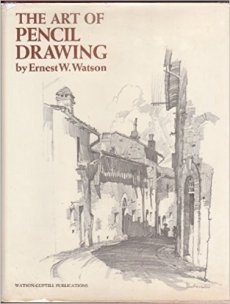I challenged myself to learn something from an art book that I thought would be time wasted from painting and drawing. As a struggling artist, I get s o wrapped up in painting and drawing that I seldom take the time to read a book about painting and drawing. I do this despite the expert information from a experienced artist leagues better than myself.
o wrapped up in painting and drawing that I seldom take the time to read a book about painting and drawing. I do this despite the expert information from a experienced artist leagues better than myself.
The book ” The Art of Pencil Drawing” by Ernest Watson is a book I have owned for years but never opened to read. I reasoned that it was counter-productive to read anything because it would be time spent away from painting and drawing.
The truth is we can spin our wheels drawing and painting without improvement. We can hit plateaus similar to body builders when the muscles have acclimated to a repetitive workout routine. I felt that I needed to mix things up and the best way to do this is to learn something new. Something unconventional… like reading a book about painting and drawing.
Let me start with some of the thoughts I had whenever I saw this book on my shelf.
- Don’t have time to read a book.
- Spending more hours drawing and painting is the only way to improve.
- The artist only draws with pencil, how can I possibly learn anything about color? (Note: I’ve said this about painting books too except ..”The artist only paints how can I learn anything about drawing. )
- Clients will not hire me because of books I’ve read only works produced.
Here are some of the lessons I’ve learned. Moving away from line dependency with the use of shadow, pattern and value.
Watson goes away from line dependency by rendering shapes with shadow, pattern and value. All edges in a drawing are shared edges, a line cannot be drawn without sharing two edges. Imagine drawing the bottom of a tree, one straight horizontal line. Now the grass shares the same plane with the bottom of that tree. The shapes must be distinguished from one another or as the artist sees fit.
Watson uses shadow to distinguish between the two shapes. Shadow and light define the forms and shapes. He uses shadows and light to accentuate the forms. This is done in varying degrees to make certain forms the focus of interest. In his drawing of the Rialto, the sculptured shapes along the steps  of the bridge are clearly defined. The dark shadows behind them help create the strong silhouette and draws the viewers attention. The most impressive thing for me is that Watson waited for the proper time of day to capture this.
of the bridge are clearly defined. The dark shadows behind them help create the strong silhouette and draws the viewers attention. The most impressive thing for me is that Watson waited for the proper time of day to capture this.
Art directing the composition and size with a clear plan was an important aspect of his drawings. He employed his drawing techniques along with composition to isolate points of interests. He would also embellish a scene to accentuate these points of interests.
I view his drawings with a lot more appreciation. I can see the choices he makes with each mark. The deliberate exclusion and inclusion of pattern and value throughout the drawing to bring the viewers attention to the point of interest. I’ve learned quite a bit from reading this book. I’ve learned a valuable approach to my own compositions using shadow, pattern and value.

You must be logged in to post a comment.